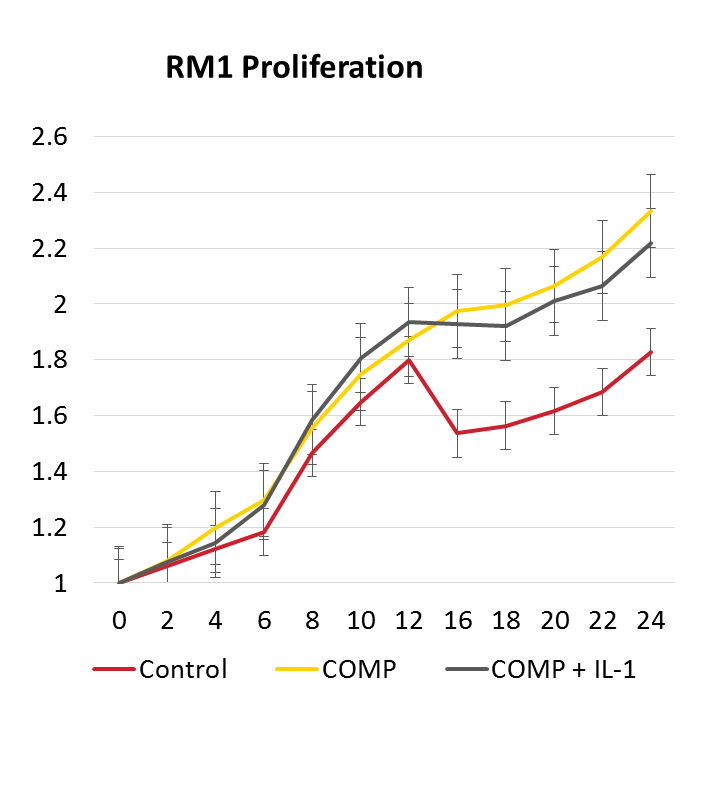Recombinant Mouse COMP Protein, CF Summary
Product Specifications
Gln20-Val755, with a C-terminal 6-His tag
Analysis
Product Datasheets
Carrier Free
CF stands for Carrier Free (CF). We typically add Bovine Serum Albumin (BSA) as a carrier protein to our recombinant proteins. Adding a carrier protein enhances protein stability, increases shelf-life, and allows the recombinant protein to be stored at a more dilute concentration. The carrier free version does not contain BSA.
In general, we advise purchasing the recombinant protein with BSA for use in cell or tissue culture, or as an ELISA standard. In contrast, the carrier free protein is recommended for applications, in which the presence of BSA could interfere.
8958-CP
| Formulation | Lyophilized from a 0.2 μm filtered solution in Tris and NaCl with Trehalose |
| Reconstitution | Reconstitute at 500 μg/mL in PBS. |
| Shipping | The product is shipped with polar packs. Upon receipt, store it immediately at the temperature recommended below. |
| Stability & Storage: | Use a manual defrost freezer and avoid repeated freeze-thaw cycles.
|
Scientific Data
 View Larger
View Larger
Recombinant Mouse COMP/Thrombospondin-5 (Catalog # 8958-CP) induces adhesion of ATDC5 mouse chondrogenic cells. The ED50 for this effect is 0.15-0.9 μg/mL.
Reconstitution Calculator
Background: COMP/Thrombospondin-5
Cartilage Oligomeric Matrix Protein (COMP), also known as Thrombospondin-5, is a 110 kDa multidomain calcium binding protein that associates with other extracellular matrix molecules. Thrombospondin-1 and -2 constitute subgroup A and form homotrimers, whereas Thrombospondin-3, -4, and COMP constitute subgroup B and form homopentamers (1-4). Mouse COMP contains a non-collagenous coiled-coil domain, four EGF-like repeats, eight TSP type-3 repeats, and a globular TSP C-terminal domain (5). It shares 92% and 98% aa sequence identity with human and rat COMP, respectively. The coiled coil domain mediates the association of COMP into disulfide-linked homopentamers with a central hub and peripheral globular domains connected by flexible strands (6, 7). An axial pore is formed by the coiled coil assembly and binds vitamin D3 which is involved in bone and cartilage metabolism (8). An RGD sequence in the third TSP type-3 repeat mediates chondrocyte attachment via Integrin alpha 5 beta 1, although when reduced and in the absence of calcium, attachment is mediated via Integrin alpha V beta 3 (9). COMP is up-regulated in rheumatoid arthritis and osteoarthritis, hepatocellular carcinomas, chronic pancreatitis, and pancreatic carcinomas (10-12). Elevated circulating COMP levels are used as a biomarker for early onset of some skeletal disorders (10). Several mutations are associated with skeletal dysplasias, and the most common, a point mutation in the third TSP type-3 repeat, results in diminished calcium binding ability (13, 14).
- Adams, J.C. and J. Lawler (2004) Int J. Biochem. Cell Biol. 36:961.
- Posey, K.L. et al. (2014) Matrix Biol. 37:167.
- Adams, J.C. (2004) Int. J. Biochem. Cell Biol. 36:1102.
- Mann, H.H. et al. (2004) J. Biol. Chem. 279:25294.
- Fang, C. et al. (2000) J. Orthop. Res. 18:593.
- DiCesare, P. et al. (1995) J. Orthopaedic Res. 13:422.
- Efimov, V.P. et al. (1994) FEBS Lett. 341:54.
- Ozbek, S., et al. (2002) EMBO J. 21:5960.
- Chen, F.H., et al. (2005) J. Biol. Chem. 280:32655.
- Wislowska, M. and B. Jablonska (2005) Clin. Rheumatol. 24:278.
- Xiao, Y. et al. (2004) J. Gastroenterol. Hepatol. 19:296.
- Liao, Q. et al. (2003) Scand. J. Gastroenterol. 38:207.
- Kennedy, J., et al. (2005) Eur. J. Hum. Genet. 13:547.
- Hou, J. et al. (2000) Cell Calcium 27:309.
FAQs
No product specific FAQs exist for this product, however you may
View all Proteins and Enzyme FAQsReviews for Recombinant Mouse COMP Protein, CF
Average Rating: 5 (Based on 1 Review)
Have you used Recombinant Mouse COMP Protein, CF?
Submit a review and receive an Amazon gift card.
$25/€18/£15/$25CAN/¥75 Yuan/¥2500 Yen for a review with an image
$10/€7/£6/$10 CAD/¥70 Yuan/¥1110 Yen for a review without an image
Filter by:


